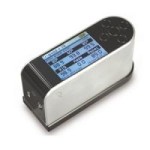News: Rhopoint IQ Image Quality Distinctness of Image DOI Goniophotometer

The Rhopoint IQ Image Quality Distinctness of Image DOI uses patented technology to measure the complex interaction of a surface with a light.Also known as the Rhopoint Novo-Gloss IQ / Image Quality / Haze Distinctness of Image / DOI / Goniophotometer / Meter.The instrument profiles complete specular reflectance and calculates gloss, peak specular reflectance, Distinctness of Image (DOI) and Reflection Haze.Complete Characterisation of Specular Appearance
- Gloss
- Specular Reflectance
- Haze ·
- Distinctness of Image (DOI) Understand Surface Quality
The Novo-Gloss IQ characterises reflective properties in a way that simulates the perception of a human observer, giving a detailed understanding of surface quality. Micro-structures on the surface of a high gloss surface can cause a reflected image to bloom and become indistinct, longer wavelength surface ripples known as orange peel can also distort this image. The Novo-Gloss IQ uses the complete specular reflectance data to calculate; Gloss, Peak Specular Reflectance, Haze and Distinctness of Image values.
Traditional specular instruments use optical masks and simple diodes to measure specified parts of the reflected image; the Novo-Gloss IQ profiles ALL specular reflectance, measuring at +/- 6 ° from the specular angle at 20 ° and 60 ° geometries.
Novo-Gloss IQ vs. Gloss, Haze and DOI Meters
Traditional specular instruments use optical masks and simple diodes to measure specified parts of the reflected image; the Novo-Gloss IQ profiles ALL specular reflectance, measuring at +/- 6 ° from the specular angle at 20 ° and 60 ° geometries.
Dual Angle Instrument
The Novo-Gloss IQ characterises surfaces at 20 ° and 60 ° geometries giving it superb resolution and the flexibility to accurately measure any surface from matt to mirror finish.
Goniophotometric Profile
Using the Novo-Soft IQ and the supplied USB data cable, the user can overlay and compare the specular reflectance curves of similar materials; this graphical fingerprint can highlight the most subtle variations in surface quality.
Gloss Measurement Verified to Existing Standards
The Novo-Gloss IQ operates within the strict angular tolerances detailed in international standards such as ASTM D523 & ISO 2813 therefore gloss values obtained on flat surfaces are indistinguishable from traditional instruments.
More Accurate Gloss Measurement
The Novo-Gloss IQ array technology makes it more accurate and repeatable than a traditional gloss meter throughout the gloss range. Traditional gloss-meters must be placed on a completely flat surface as slight variations in sample curvature or instrument placement will result in large errors, the Novo-Gloss IQ automatically adjusts for curvature or positioning errors and calculates true gloss values.
Peak Specular Reflectance
The instrument calculates the peak specular reflectance of a surface, a value that is independent of sample curvature, positioning, Haze and DOI effects.
Haze
Reflection Haze is defined as the spread of the specular component of reflected light from a glossy surface. Surface Haze is often caused by micro-structures on the top surface of the glossy material and is observed as “blooming” or “milky halo” around the reflected image. This characteristic is undetectable with a traditional gloss meter but is often associated with a drop in the perceived quality of a sample.
Distinctness of Image (DOI)
The DOI of a material determines how clearly an observer can discern a reflected image in its surface. Human perception associates “high quality” to surfaces that demonstrate excellent reflective properties, especially ones which show a “deep”, “clear” and “crisp” glossiness. By measuring DOI with Novo-Gloss IQ the user can objectively determine the reflective properties of high quality materials. The DOI of a surface is affected by gloss, haze and surface distortions such as polish marks and orange peel.
Click here for the Product Page of the Rhopoint IQ

